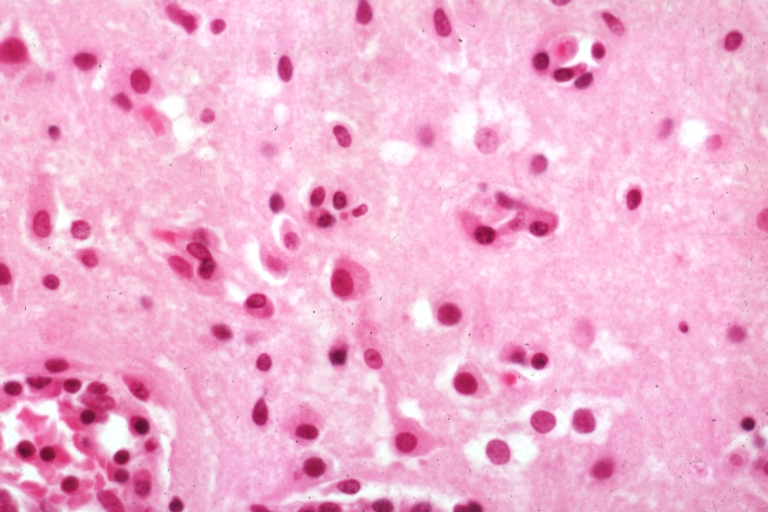Subacute sclerosing panencephalitis: Difference between revisions
Varun Kumar (talk | contribs) No edit summary |
m (Changes made per Mahshid's request) |
||
| (8 intermediate revisions by 3 users not shown) | |||
| Line 1: | Line 1: | ||
__NOTOC__ | |||
'''For patient information, click [[Subacute sclerosing panencephalitis (patient information)|here]]''' | '''For patient information, click [[Subacute sclerosing panencephalitis (patient information)|here]]''' | ||
{{Infobox_Disease | | {{Infobox_Disease | | ||
Name = Subacute sclerosing panencephalitis | | Name = Subacute sclerosing panencephalitis | | ||
Image = Subacute sclerosing panencephalitis 1.jpg| | Image = Subacute sclerosing panencephalitis 1.jpg| | ||
Caption = Brain: Subacute Sclerosing Panencephalitis: Micro high mag H&E inflammatory reaction (well depicted). <br> <small> [http://www.peir.net Image courtesy of Professor Peter Anderson DVM PhD and published with permission © PEIR, University of Alabama at Birmingham, Department of Pathology] </small>| | Caption = Brain: Subacute Sclerosing Panencephalitis: Micro high mag H&E inflammatory reaction (well depicted). <br> <small> [http://www.peir.net Image courtesy of Professor Peter Anderson DVM PhD and published with permission © PEIR, University of Alabama at Birmingham, Department of Pathology] </small>| | ||
}} | }} | ||
{{ | {{Subacute sclerosing panencephalitis}} | ||
{{CMG}} | {{CMG}} | ||
{{SK}} SSPE | {{SK}} SSPE; Dawson disease; Dawson encephalitis; measles encephalitis | ||
==[[Subacute sclerosing panencephalitis overview|Overview]]== | |||
==[[Subacute sclerosing panencephalitis historical perspective|Historical Perspective]]== | |||
== | ==[[Subacute sclerosing panencephalitis pathophysiology|Pathophysiology]]== | ||
== | ==[[Subacute sclerosing panencephalitis causes|Causes]]== | ||
=== | ==[[Subacute sclerosing panencephalitis differential diagnosis|Differentiating Subacute sclerosing panencephalitis from other Diseases]]== | ||
==[[Subacute sclerosing panencephalitis epidemiology and demographics|Epidemiology and Demographics]]== | |||
==[[Subacute sclerosing panencephalitis risk factors|Risk Factors]]== | |||
==[[Subacute sclerosing panencephalitis natural history|Natural History, Complications and Prognosis]]== | |||
==Diagnosis== | ==Diagnosis== | ||
[[Subacute sclerosing panencephalitis history and symptoms|History and Symptoms]] | [[Subacute sclerosing panencephalitis physical examination|Physical Examination]] | [[Subacute sclerosing panencephalitis laboratory tests|Laboratory Findings]] | [[Subacute sclerosing panencephalitis CT|CT]] | [[Subacute sclerosing panencephalitis MRI|MRI]] | [[Subacute sclerosing panencephalitis other imaging findings|Other Imaging Findings]] | [[Subacute sclerosing panencephalitis other diagnostic studies|Other Diagnostic Studies]] | |||
==Treatment== | ==Treatment== | ||
[[Subacute sclerosing panencephalitis medical therapy|Medical Therapy]] | [[Subacute sclerosing panencephalitis primary prevention|Primary Prevention]] | [[Subacute sclerosing panencephalitis cost-effectiveness of therapy|Cost-Effectiveness of Therapy]] | [[Subacute sclerosing panencephalitis future or investigational therapies|Future or Investigational Therapies]] | |||
==Case Studies== | |||
[[Subacute sclerosing panencephalitis case study one|Case #1]] | |||
{{Viral diseases}} | {{Viral diseases}} | ||
{{Symptoms and signs}} | {{Symptoms and signs}} | ||
[[es:panencefalitis esclerosante subaguda]] | [[es:panencefalitis esclerosante subaguda]] | ||
| Line 59: | Line 49: | ||
[[fi:Subakuutti sklerosoiva panenkefaliitti]] | [[fi:Subakuutti sklerosoiva panenkefaliitti]] | ||
[[zh:稍尖的硬化全脑炎]] | [[zh:稍尖的硬化全脑炎]] | ||
{{WikiDoc Help Menu}} | {{WikiDoc Help Menu}} | ||
{{WikiDoc Sources}} | {{WikiDoc Sources}} | ||
[[Category:Disease]] | |||
[[Category:Neurology]] | |||
[[Category:Neurological disorders]] | [[Category:Neurological disorders]] | ||
[[Category:Viral diseases]] | [[Category:Viral diseases]] | ||
[[Category:Inflammations]] | [[Category:Inflammations]] | ||
Latest revision as of 18:52, 18 September 2017
For patient information, click here
| Subacute sclerosing panencephalitis | |
 | |
|---|---|
| Brain: Subacute Sclerosing Panencephalitis: Micro high mag H&E inflammatory reaction (well depicted). Image courtesy of Professor Peter Anderson DVM PhD and published with permission © PEIR, University of Alabama at Birmingham, Department of Pathology |
|
Subacute sclerosing panencephalitis Microchapters |
|
Differentiating Subacute sclerosing panencephalitis from other Diseases |
|---|
|
Diagnosis |
|
Treatment |
|
Case Studies |
|
Subacute sclerosing panencephalitis On the Web |
|
American Roentgen Ray Society Images of Subacute sclerosing panencephalitis |
|
Directions to Hospitals Treating Subacute sclerosing panencephalitis |
|
Risk calculators and risk factors for Subacute sclerosing panencephalitis |
Editor-In-Chief: C. Michael Gibson, M.S., M.D. [1]
Synonyms and keywords: SSPE; Dawson disease; Dawson encephalitis; measles encephalitis
Overview
Historical Perspective
Pathophysiology
Causes
Differentiating Subacute sclerosing panencephalitis from other Diseases
Epidemiology and Demographics
Risk Factors
Natural History, Complications and Prognosis
Diagnosis
History and Symptoms | Physical Examination | Laboratory Findings | CT | MRI | Other Imaging Findings | Other Diagnostic Studies
Treatment
Medical Therapy | Primary Prevention | Cost-Effectiveness of Therapy | Future or Investigational Therapies
Case Studies
Template:Skin and subcutaneous tissue symptoms and signs Template:Nervous and musculoskeletal system symptoms and signs Template:Urinary system symptoms and signs Template:Cognition, perception, emotional state and behaviour symptoms and signs Template:Speech and voice symptoms and signs Template:General symptoms and signs
fi:Subakuutti sklerosoiva panenkefaliitti